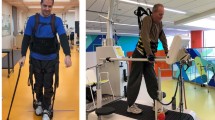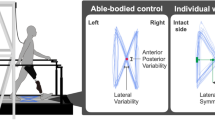Abstract
The purpose of this paper is to report the cardiopulmonary stresses (as indicated by heart rate, blood pressure, oxygen consumption and task cost) for a tetraplegic individual when walking with electrical stimulation and a gait orthosis as opposed to walking with a gait orthosis alone. Functional electrical stimulation (FES), when interfaced with a reciprocating gait orthosis (RGO), resulted in walking exercise for a C-7 level tetraplegic subject, who was 8 years post-injury. Cardiopulmonary measurements were made and task costs calculated on this individual during progressive velocity walking with the FES-RGO and the orthosis alone (without FES). Results for the tetraplegic individual indicate that there were no significant changes in heart rate at the various walking velocities with respect to the two systems. However, systolic blood pressure was significantly reduced at the three highest walking velocities (1.2, 1.6 and 2.0 kph) when using the FES and orthosis system as compared to orthosis-alone walking (p<.025, p<.005 and p<.025 respectively). Calculated oxygen consumption was significantly reduced and calculated task cost improved at the highest walking velocity (2.0 kph) when using the FES-RGO system as compared to using only the RGO (p<.025). It is concluded that cardiopulmonary stresses are significantly less for this tetraplegic individual when ambulating at the higher velocities with electrical stimulation and a gait orthosis than when walking with a gait orthosis alone. This may result in improved endurance during each walking session and (consequently) an improved aerobic exercise effect. This might also allow some tetraplegics, who would be unable to walk with the RGO alone, to walk with electrical stimulation and the RGO.
Similar content being viewed by others
Log in or create a free account to read this content
Gain free access to this article, as well as selected content from this journal and more on nature.com
or
References
Douglas R, Larson P D'Aubrosia R, McCall R 1983 LSU reciprocating gait orthosis. Orthopedics 6: 834–839.
Knuttson E, Lewenhaupt-Olsson E, Thorsen M 1973 Physical work capacity and physical conditioning in paraplegic patients. Paraplegia 11: 205–216.
McCall R E, Douglas R, Nicholas R 1983 Surgical treatment in patients with myelodysplasia before using the LSU reciprocating system. Orthopedics 6: 843–848.
Petrofsky J S, Phillips C A, Douglas R, Larson P 1986 A computer-controlled walking system: The combination of an orthosis with functional electrical stimulation. J Clin Engrg 11: 121–133.
Petrofsky J S, Phillips C A, Larson P, Douglas R 1985 Computer-synthesized walking-an application of orthosis and functional electrical stimulation (FES). Journal of Neurological and Orthopedic Medical and Surgery 6: 219–230.
Phillips C A 1987 The medical criteria for active physical therapy: physician guidelines for patient participation in a program of functional electrical rehabilitation. American Journal of Physical Medicine 66: 269–286.
Phillips C A 1989a Functional electrical stimulation and lower extremity bracing for ambulation exercise of the S.C.I, individual: A medically prescribed system. Physical Therapy 69: 842–849.
Phillips C A 1989b An interactive system of electronic stimulators and gait orthosis for walking in the spinal cord injured. Automedica (Lond.), 11: 247–261.
Phillips C A, Heard D, Hendershot D, Koubek R 1990 A sensory feedback system for control of constant gait velocity: Application for E.M.S.-R.G.O. exercise. Engrg. Med. Biol. Soc. 12th Annual International Conference 12: 2260–2261.
Phillips C A, Petrofsky J S, Hendershot D M, Stafford D 1984 Functional electrical exercise: a comprehensive approach for physical conditioning of the spinal cord injured individual. Orthopedics 7: 112–1123.
Pierrynowski M R, Winter D A, Norman R W 1981 Metabolic measures to ascertain the optimal load to be carried by man. Ergonomics 24: 393–399.
Solomonow M, Baratta R, Shoji H et al 1988 F.E.S. powered locomotion of paraplegics fitted with the L.S.U. R.G.O. I.E.E.E. Engrg. Med. Biol. Soc. 10th Ann Internat Conf, 10: 1672.
Yngve D, Douglas R, Roberts J M 1984 The reciprocation gait orthosis and myelomeningocele. Journal of Pediatric Orthopedics 4: 304–310.
Author information
Authors and Affiliations
Rights and permissions
About this article
Cite this article
Phillips, C., Hendershot, M. Functional electrical stimulation and reciprocating gait orthosis for ambulation exercise in a tetraplegic patient: a case study. Spinal Cord 29, 268–276 (1991). https://doi.org/10.1038/sc.1991.38
Issue date:
DOI: https://doi.org/10.1038/sc.1991.38
Keywords
This article is cited by
-
Functional walking ability of paraplegic patients: comparison of functional electrical stimulation versus mechanical orthoses
European Journal of Orthopaedic Surgery & Traumatology (2013)



